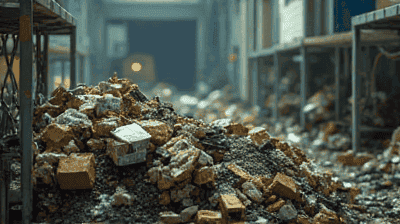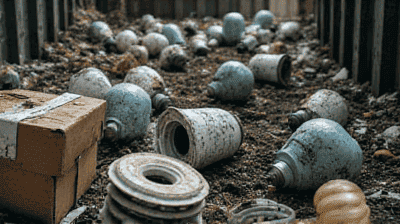
The increasing reliance on technology in our daily lives has led to the generation of substantial amounts of electronic waste, or e-waste. This category of waste encompasses discarded electronic devices like smartphones, computers, televisions, and various other gadgets. Alongside e-waste, fluorescent bulbs—widely used for their energy efficiency—contain mercury, a toxic heavy metal that poses significant environmental and health risks when mishandled. As these products reach the end of their life cycle, understanding the dangers of mercury as well as the importance of proper disposal methods becomes critical for protecting both human health and the environment.
E-waste refers to any electronic device that has reached the end of its useful life. As technology advances rapidly, devices become obsolete, often leading to their disposal. E-waste can include:
E-waste is not only vast in volume but also diverse in composition, containing various materials such as plastics, metals, glass, and hazardous substances—including mercury.
Fluorescent bulbs are a type of lighting that have gained popularity due to their energy efficiency compared to traditional incandescent bulbs. They work by passing an electric current through a gas, which then produces ultraviolet light. This light stimulates a fluorescent coating inside the bulb, emitting visible light.
However, many fluorescent bulbs contain mercury, a potent neurotoxin that can cause significant harm to both human health and the environment if not disposed of correctly. Understanding the composition of these bulbs is crucial for recognizing the implications of improper disposal.

Mercury exposure can lead to severe health issues, as it is a neurotoxin that affects the brain and nervous system. Here are some key health concerns associated with mercury:
The effects of mercury exposure are particularly concerning for vulnerable populations, including children, pregnant women, and people with preexisting health conditions.
When improperly disposed of, mercury can enter the environment, leading to widespread pollution. Key environmental concerns include:
The environmental impact of mercury can have long-lasting effects, compromising the health of entire ecosystems and communities.
The Basel Convention on the Control of Transboundary Movements of Hazardous Wastes and Their Disposal is an international treaty designed to reduce hazardous waste production and ensure environmentally sound disposal. Under this convention, mercury-containing waste is classified as hazardous, requiring adherence to strict regulations for its handling and disposal.
In the United States, the Resource Conservation and Recovery Act governs the disposal of hazardous waste, including those containing mercury. The RCRA establishes:
Many states in the U.S. have enacted additional regulations to specifically address the disposal of fluorescent bulbs and e-waste containing mercury. These regulations often include:

Recycling is one of the most effective methods for managing e-waste and fluorescent bulbs. Proper recycling facilities can recover valuable materials and safely manage hazardous components. Here are key practices for effective recycling:
To minimize risks associated with e-waste disposal, individuals and organizations should follow proper handling practices:
Public awareness plays a crucial role in ensuring responsible disposal practices. Organizations and municipalities must engage in educational initiatives to inform citizens about the importance of proper disposal. Practices include:
Businesses should establish comprehensive waste management programs focused on the safe handling of hazardous materials. Here are key components to consider:
Advances in recycling technology play a crucial role in improving the handling of e-waste and fluorescent bulbs. Some developments include:
With increasing reliance on technology in everyday life, mobile applications can facilitate responsible disposal:

Sweden is renowned for its effective e-waste management strategies. The country has established a comprehensive recycling system that encourages residents to recycle their electronic devices.
Outcomes: With over 80% of e-waste being collected for recycling, Sweden has successfully diverted millions of tons of waste from landfills while ensuring the safe handling of hazardous materials, including mercury.
California has implemented a statewide program aimed at the safe disposal of fluorescent bulbs. This program includes a network of collection points and retail drop-off centers specifically for used bulbs.
Outcomes: The state has successfully increased recycling rates while reducing the amount of mercury entering landfills, ensuring safer environmental outcomes.
The WEEE Directive aims to reduce e-waste generation and promote the recycling of electronic devices. EU member states are required to provide facilities for the collection and recycling of e-waste.
Outcomes: As a result, many countries have implemented effective collection systems that ensure the recovery of toxic substances, including mercury, reducing environmental impact.
Community involvement plays an essential role in promoting responsible disposal practices. Grassroots organizations can advocate for improved recycling initiatives and educate the public about the dangers associated with mercury-containing waste.
Collaboration between local governments, businesses, and communities can lead to the successful implementation of waste management strategies:
Involvement in policy advocacy can lead to more stringent regulations and improved management practices:
Mercury-containing waste, particularly in e-waste and fluorescent bulbs, presents significant environmental and health challenges when poorly managed. Understanding the dangers associated with mercury and the critical importance of proper disposal is essential for reducing risks to public health and preserving the environment.
By adhering to regulations, adopting best practices, and fostering community awareness, individuals and organizations can actively contribute to responsible waste management and advocate for sustainable solutions. As the world continues to evolve into a technologically advanced society, it is crucial to prioritize the safe handling and disposal of hazardous materials. Together, we can work towards a cleaner, healthier future for our planet.